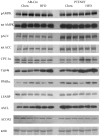Short term feeding of a high fat diet exerts an additive effect on hepatocellular damage and steatosis in liver-specific PTEN knockout mice
- PMID: 24818992
- PMCID: PMC4018288
- DOI: 10.1371/journal.pone.0096553
Short term feeding of a high fat diet exerts an additive effect on hepatocellular damage and steatosis in liver-specific PTEN knockout mice
Abstract
Background: Hepatospecific deletion of PTEN results in constitutive activation of Akt and increased lipogenesis. In mice, the addition of a high fat diet (HFD) downregulates lipogenesis. The aim of this study was to determine the effects of a HFD on hepatocellular damage induced by deletion of PTEN.
Methods: 12 Week old male flox/flox hepatospecific PTEN mice (PTENf/f) or Alb-Cre controls were fed a HFD composed of 45% fat-derived calories (from corn oil) or a normal chow. Animals were then analyzed for hepatocellular damage, oxidative stress and expression of enzymes involved in fatty acid metabolism.
Results: In the Alb-Cre animals, the addition of a HFD resulted in a significant increase in liver triglycerides and altered REDOX capacity as evidenced by increased GPX activity, decreased GST activity and decreased hepatic concentrations of GSSG. In addition, SCD2, ACLY and FASN were all downregulated by the addition of HFD. Furthermore, expression of PPARα and PPARα-dependent proteins Cyp4a and ACSL1 were upregulated. In the PTENf/f mice, HFD resulted in significant increased in ALT, serum triglycerides and decreased REDOX capacity. Although expression of fatty acid synthetic enzymes was elevated in the chow fed PTENf/f group, the addition of HFD resulted in SCD2, ACLY and FASN downregulation. Compared to the Alb-Cre HFD group, expression of PGC1α, PPARα and its downstream targets ACSL and Cyp4a were upregulated in PTENf/f mice.
Conclusions: These data suggest that during conditions of constitutive Akt activation and increased steatosis, the addition of a HFD enhances hepatocellular damage due to increased CD36 expression and altered REDOX status. In addition, this work indicates HFD-induced hepatocellular damage occurs in part, independently of Akt signaling.
Conflict of interest statement
Figures






Similar articles
-
Liver-Specific Deletion of Phosphatase and Tensin Homolog Deleted on Chromosome 10 Significantly Ameliorates Chronic EtOH-Induced Increases in Hepatocellular Damage.PLoS One. 2016 Apr 28;11(4):e0154152. doi: 10.1371/journal.pone.0154152. eCollection 2016. PLoS One. 2016. PMID: 27124661 Free PMC article.
-
Loss of NAT10 alleviates maternal high-fat diet-induced hepatic steatosis in male offspring of mice.Obesity (Silver Spring). 2024 Jul;32(7):1349-1361. doi: 10.1002/oby.24041. Epub 2024 May 30. Obesity (Silver Spring). 2024. PMID: 38816990
-
Inhibition of p53 attenuates steatosis and liver injury in a mouse model of non-alcoholic fatty liver disease.J Hepatol. 2013 Apr;58(4):785-91. doi: 10.1016/j.jhep.2012.11.042. Epub 2012 Dec 2. J Hepatol. 2013. PMID: 23211317 Free PMC article.
-
Glial cell line-derived neurotrophic factor protects against high-fat diet-induced hepatic steatosis by suppressing hepatic PPAR-γ expression.Am J Physiol Gastrointest Liver Physiol. 2016 Jan 15;310(2):G103-16. doi: 10.1152/ajpgi.00196.2015. Epub 2015 Nov 12. Am J Physiol Gastrointest Liver Physiol. 2016. PMID: 26564715 Free PMC article.
-
SIRT3 deficiency exacerbates fatty liver by attenuating the HIF1α-LIPIN 1 pathway and increasing CD36 through Nrf2.Cell Commun Signal. 2020 Sep 10;18(1):147. doi: 10.1186/s12964-020-00640-8. Cell Commun Signal. 2020. PMID: 32912335 Free PMC article.
Cited by
-
Differential carbonylation of proteins in end-stage human fatty and nonfatty NASH.Free Radic Biol Med. 2017 Dec;113:280-290. doi: 10.1016/j.freeradbiomed.2017.10.004. Epub 2017 Oct 6. Free Radic Biol Med. 2017. PMID: 28988798 Free PMC article.
-
Cholestatic liver disease results increased production of reactive aldehydes and an atypical periportal hepatic antioxidant response.Free Radic Biol Med. 2019 Nov 1;143:101-114. doi: 10.1016/j.freeradbiomed.2019.07.036. Epub 2019 Aug 1. Free Radic Biol Med. 2019. PMID: 31377417 Free PMC article.
-
Signaling through non-membrane nuclear phosphoinositide binding proteins in human health and disease.J Lipid Res. 2019 Feb;60(2):299-311. doi: 10.1194/jlr.R088518. Epub 2018 Sep 10. J Lipid Res. 2019. PMID: 30201631 Free PMC article. Review.
-
Elevated Nrf-2 responses are insufficient to mitigate protein carbonylation in hepatospecific PTEN deletion mice.PLoS One. 2018 May 25;13(5):e0198139. doi: 10.1371/journal.pone.0198139. eCollection 2018. PLoS One. 2018. PMID: 29799837 Free PMC article.
-
Close interactions between lncRNAs, lipid metabolism and ferroptosis in cancer.Int J Biol Sci. 2021 Oct 25;17(15):4493-4513. doi: 10.7150/ijbs.66181. eCollection 2021. Int J Biol Sci. 2021. PMID: 34803512 Free PMC article. Review.
References
-
- Watanabe S, Horie Y, Suzuki A (2005) Hepatocyte-specific Pten-deficient mice as a novel model for nonalcoholic steatohepatitis and hepatocellular carcinoma. Hepatol Res 33: 161–166. - PubMed
-
- Hashizume H, Sato K, Takagi H, Hirokawa T, Kojima A, et al. (2007) Primary liver cancers with nonalcoholic steatohepatitis. Eur J Gastroenterol Hepatol 19: 827–834. - PubMed
-
- Watanabe S, Horie Y, Kataoka E, Sato W, Dohmen T, et al. (2007) Non-alcoholic steatohepatitis and hepatocellular carcinoma: lessons from hepatocyte-specific phosphatase and tensin homolog (PTEN)-deficient mice. J Gastroenterol Hepatol 22 Suppl 1S96–S100. - PubMed
-
- Richardson MM, Jonsson JR, Powell EE, Brunt EM, Neuschwander-Tetri BA, et al. (2007) Progressive fibrosis in nonalcoholic steatohepatitis: association with altered regeneration and a ductular reaction. Gastroenterology 133: 80–90. - PubMed
Publication types
MeSH terms
Substances
Grants and funding
LinkOut - more resources
Full Text Sources
Other Literature Sources
Molecular Biology Databases
Research Materials
Miscellaneous

